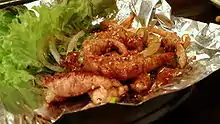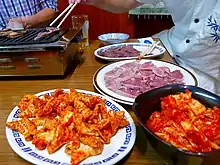Horumonyaki
Horumonyaki (Japanese: ホルモン焼き) is a kind of Japanese cuisine made from beef or pork offal. Kitazato Shigeo, the chef of a yōshoku restaurant (one that specializes in Western-derived cuisine) in Osaka devised this dish and registered a trademark in 1940.[1] It was originally derived from Yakiniku, a Japanese adaption of Korean barbecue.[2][3] The name horumon is derived from the word "hormone", which means "stimulation" in Greek. The name horumon is also similar to the Kansai dialect term hōrumon (放る物), which means "discarded goods". Horumonyaki has a reputation for being a "stamina building" food.[4]


Although horumon may be beef or pork, pork is more commonly used. (Note: Names vary considerably depending on the source animal and also on regional dialect.) Common horumon items include:
- gari: esophagus
- haatsu: heart
- haatsumoto ("heart-base"): pulmonary artery
- kobukuro: uterus
- oppai ("teat"): mammary
- sagari: diaphragm
- shibire: pancreas
- shiro ("white"): intestine
- teppō ("rifle"): rectum
References
- 語源由来辞典 (Etymological dictionary) Horumonyaki
- Multiethnic Japan By John Lie
- Race, Ethnicity and Migration in Modern Japan: Race, ethnicity and culture By Michael Weiner
- "History of Manjū-ya, a motsunabe restaurant". Manjū-ya. Archived from the original on 2012-06-30. Retrieved 2016-02-14.CS1 maint: ref=harv (link)